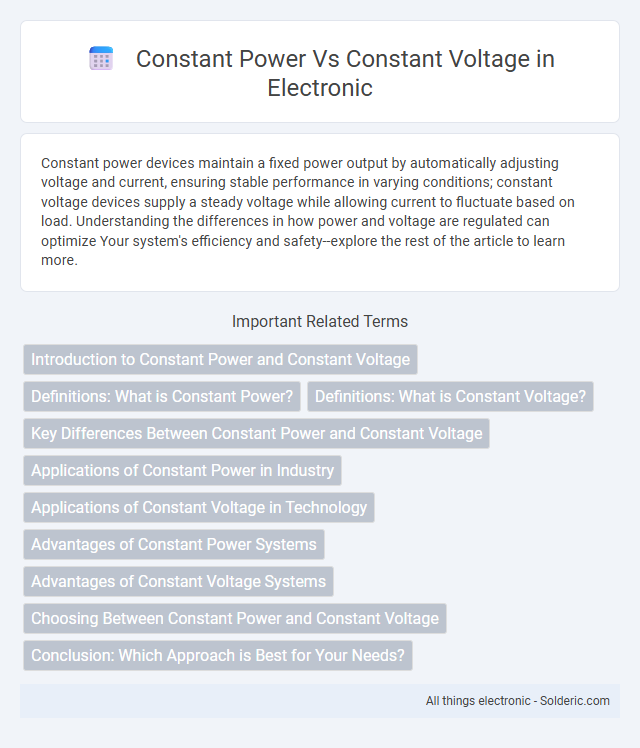Constant power devices maintain a fixed power output by automatically adjusting voltage and current, ensuring stable performance in varying conditions; constant voltage devices supply a steady voltage while allowing current to fluctuate based on load. Understanding the differences in how power and voltage are regulated can optimize Your system's efficiency and safety--explore the rest of the article to learn more.
Comparison Table
| Feature | Constant Power | Constant Voltage |
|---|---|---|
| Definition | Maintains steady power output regardless of load changes. | Maintains fixed voltage output regardless of load changes. |
| Use Case | Power supplies, battery chargers, LED drivers requiring stable power. | Electrical systems, devices needing stable voltage like lamps, circuits. |
| Output Behavior | Adjusts voltage and current to keep power constant. | Keeps voltage constant, current varies with load. |
| Example Devices | DC-DC converters, constant power loads. | Transformers, regulated power supplies. |
| Advantages | Prevents power dips; ideal for sensitive electronics. | Stable voltage improves device lifespan and performance. |
| Limitations | Complex control; may cause voltage fluctuations. | Power output varies; not suitable for constant power devices. |
Introduction to Constant Power and Constant Voltage
Constant Power systems maintain a fixed power output regardless of voltage fluctuations, ensuring stable energy delivery in applications like power electronics and battery management. Constant Voltage systems regulate voltage to a prescribed level, commonly used in power supplies and electrical grids to protect devices and maintain performance. Understanding the distinction between constant power and constant voltage is crucial for optimizing efficiency and safety in electrical engineering designs.
Definitions: What is Constant Power?
Constant Power refers to an electrical load or device that maintains a steady power output regardless of voltage or current changes, ensuring consistent energy delivery. Unlike Constant Voltage systems that keep voltage fixed while current varies, Constant Power devices adjust voltage and current simultaneously to sustain the same power level. Understanding this concept is crucial for applications like power electronics and battery management, where your system's efficiency and performance depend on stable power supply.
Definitions: What is Constant Voltage?
Constant voltage refers to an electrical power supply or source that maintains a fixed voltage level despite variations in load current. This ensures that the voltage output remains stable, providing consistent power to devices or circuits connected to the source. It is commonly used in applications like voltage regulators, power adapters, and battery chargers to protect components from voltage fluctuations.
Key Differences Between Constant Power and Constant Voltage
Constant power systems maintain a steady power output regardless of voltage fluctuations, ensuring that your connected devices receive consistent energy. Constant voltage systems, on the other hand, supply a fixed voltage level, with power varying according to the load resistance. Understanding these key differences helps tailor your electrical setup to specific applications, enhancing performance and reliability.
Applications of Constant Power in Industry
Constant power applications are crucial in industries requiring precise energy management, such as electric vehicle drivetrains where motors must deliver consistent power despite varying loads. Industrial robotics rely on constant power control to ensure steady performance and accuracy during complex tasks, enhancing productivity and reducing downtime. In power electronics, constant power converters regulate output to protect sensitive equipment and optimize energy efficiency in manufacturing processes.
Applications of Constant Voltage in Technology
Constant voltage power supplies are crucial in LED lighting systems, ensuring stable illumination by providing a fixed voltage regardless of load changes. They are widely used in consumer electronics like smartphones and laptops to maintain consistent device performance and prevent damage from voltage fluctuations. Furthermore, constant voltage is essential in battery charging circuits to deliver precise voltage, promoting safe and efficient energy storage.
Advantages of Constant Power Systems
Constant power systems maintain a stable output regardless of load variations, improving energy efficiency and minimizing power loss. These systems provide reliable performance for critical applications such as data centers and telecommunications by preventing voltage fluctuations. Your equipment benefits from enhanced protection and operational consistency with constant power technology.
Advantages of Constant Voltage Systems
Constant voltage systems offer the advantage of simplified wiring and ease of installation, making them ideal for low-voltage lighting and electronic devices. These systems provide consistent voltage output regardless of load changes, ensuring stable performance and reducing the risk of damage to sensitive equipment. Your electrical setup can benefit from enhanced flexibility and safety with the use of constant voltage controls.
Choosing Between Constant Power and Constant Voltage
Choosing between constant power and constant voltage depends on the application's requirements for stability and efficiency. Constant voltage is ideal for devices that need a steady voltage supply, such as LED lighting or battery charging systems, ensuring consistent operation without fluctuations. You should opt for constant power in scenarios like motor drives or laser diodes, where maintaining a consistent power output optimizes performance and prevents damage.
Conclusion: Which Approach is Best for Your Needs?
Constant power delivers a stable output regardless of fluctuations in voltage, making it ideal for applications requiring consistent performance under varying conditions. Constant voltage systems maintain a fixed voltage level, ensuring simplicity and compatibility with many devices, especially in low-power or sensitive electronics. Your choice depends on the specific demands of your application, with constant power suited for dynamic loads and constant voltage favored for steady, predictable operations.
Constant Power vs Constant Voltage Infographic

 solderic.com
solderic.com